What is a composting toilet? Your complete guide to how they work
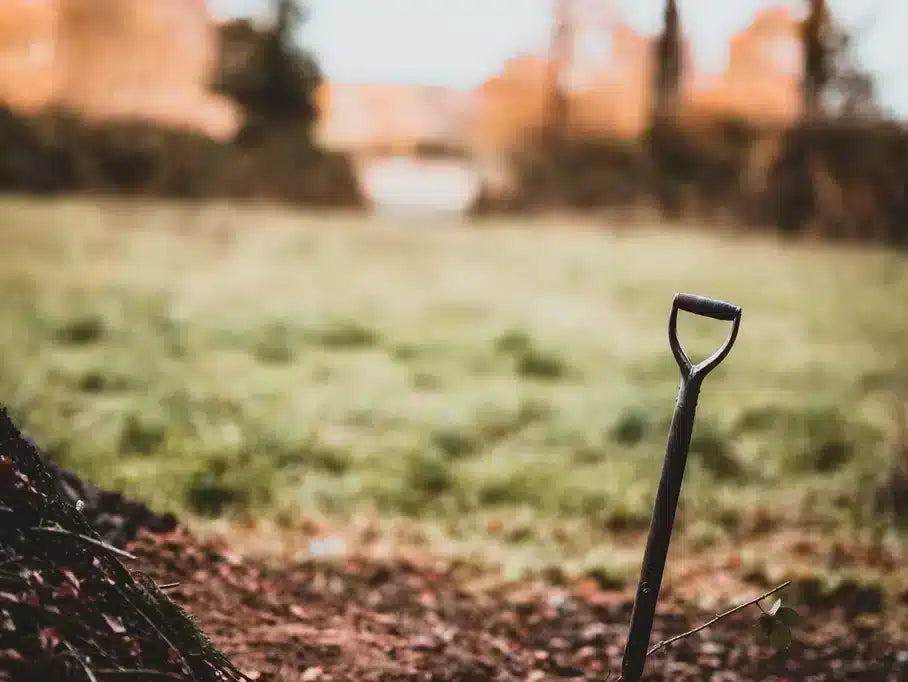
Despite their simplicity - there is a lot of confusion about what a composting toilet really is and new products coming to market in recent years have added to the confusion. To us at CompoCloset, a composting toilet begins the process of treating human waste through natural composting which helps reduce odors. When they are part of a composting toilet system, they are an affordable, environmentally sustainable and safe form of sanitation that produces a nutrient rich soil amendment.
Jump To
What a Composting toilet is NOT
Is a composting toilet a waterless toilet?
Types of Composting Toilet
There are several types of composting toilet available and for each the composting toilet system will look slightly different. Below are the main types of composting toilets
A composting toilet works by using aerobic bacteria to begin transforming human waste into a humus-like material suitable for use as fertilizer. Unlike traditional toilets which flush waste away into a septic tank or sewage system, composting toilets treat waste locally to produce a solid substance similar to humus while liquids are separated to ensure an aerobic environment for the microbial activity.
Batch Composting toilet
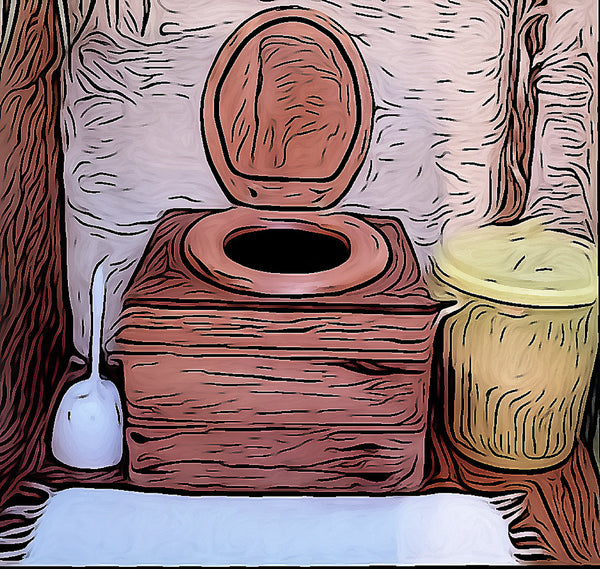
This is the most common type of Composting toilet and what most people will think of when asked "what is a composting toilet?". With the batch system, the toilet materials are manually transferred to a central compost heap. In its simplest form, this type of composting toilet consists of a bucket within an appropriate housing and a carbon rich material like coconut fiber or sawdust is added after each deposit. The carbon materials provide the food for aerobic decomposition by bacteria and maintain the right carbon nitrogen balance.
Urine diversion is common in batch systems due to the ease of managing the urine separately. Separating the liquid and solid wastes requires less bulking material to absorb moisture and also means not handling the solid materials as often.
Chamber / Moldering toilet
The chamber, or moldering toilet is a scaled up version of the smaller batch composting toilet. The larger chamber means less frequent maintenance. liquids are diverted to a separate container or allowed to drain out of the solids tank.
Split system composting toilet
The split system composting toilet features two or more chambers that are used alternatively. The first is filled and then covered over to compost while the second is used. When the second is full the contents in the first are composted and ready to be removed so the original chamber can be used again.
This type of system has been developed and promoted by ecosan and is one of the cheapest, safest and simplest forms of sustainable sanitation.
Self Contained Composting Toilet
A self contained composting toilet is simple to install and typically only requires modest amounts of electricity. They typically feature an agitator for the solids and ventilation by means of a small electric fan to provide airflow and reduce odor. Some may feature heating to help dry the materials and urine if urine diversion is not employed.
Central Composting system
A central composting system may have multiple toilets connected to a central composting vessel. Toilet materials are transported via a means of conveyance such as low flush or vacuum flush. The central composting chamber should be sized appropriately for the number of persons using it so that ideally only periodic (quarterly) maintenance is required.
For more detail check out this article on composting toilet systems.
What are the advantages of a dry composting toilet?
Are compost toilets worth the hype? Let’s explore the pros and cons of toilets that compost.
-
They save money - Compost toilets save money because you dump them less often, no chemicals or special cartridges to buy.
-
It also saves water and eliminates wastewater - They can save approximately 6600 gallons (24,984 L) of water per person per year
-
Cheaper than a septic tank
-
More Eco friendly toilet option.
-
Excellent for off grid or emergency toilet.
-
Solves toilet troubles in places where septic systems are a no-go
-
Gardening benefits and creates compost for your plants ( in around 6-12 months)
What about the disadvantages of a compost toilet?
Naturally, there are a few downsides to a natural compost toilet system:
-
Some toilets that compost do not have a diverter - the addition of liquids into the solid bin requires additional cover material leading to more regular empties - a difference of at least one month for the solids bin!
-
Smaller portable toilet systems have limited capacity and require a safe place to complete the composting process.
-
If not maintained properly, they could get a little stinky
-
Unlike traditional toilets, they require manually emptying
-
And that’s it!
Because of their simplicity, composting toilets are popular for off-grid locations like a tiny house, RV, Cabin or Boat. They can be setup to not require a water supply or electric fan yet still be odourless.
What is a urine diverter?

Sometimes, you’ll see a special separator inside a compost toilet, sometimes under the toilet seat or even part of the toilet seat. This is called a urine diverter or a toilet diverter found in all UDDTs (urine diverting dry toilets). As the name suggests, a urine diverter separates liquids from solids. This is essential in eliminating the sewage smell – and also makes emptying a composting toilet much more pleasant!
The separated urine is often collected in a urine container and can be diluted with water to be used as fertiliser. Alternatively it can be connected to a drainage system or sewer system.
Most of the volume us urine and most of the ick factor comes from handling poop and poop contains most of the pathogens (urine is typically pretty sterile). Urine diversion helps keep pee and poop separate so reduces the amount of handling of poop.
A composting toilet can be urine diverting, and a urine diverting toilet can be composting - but they aren't always.
Composting toilets do not have to feature urine diversion. Many do as this reduces odor and the volume of bulking material required and reduces the running cost of the toilet and amount of emptying required.
Conversely, a urine diverting toilet does not have to be a composting toilet. Indeed there are flush toilets that feature urine diversion to help reduce water consumption!
Just because a toilet features a urine diverter does not make it a composting toilet. there are composting toilets without urine diverters and flush toilets with urine diverters!
Composting Toilet Agitators
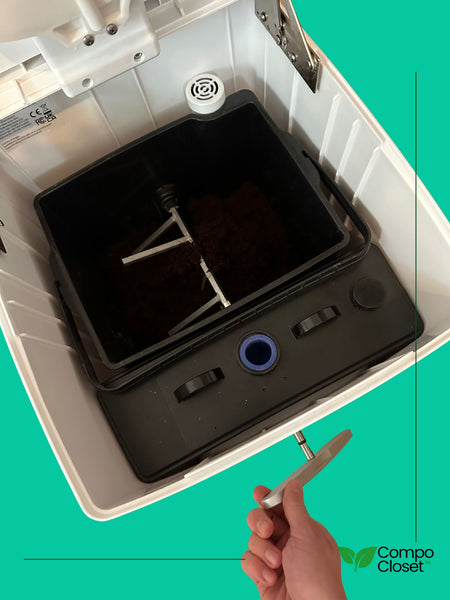
When I designed Cuddy, I designed it with an agitator because I wanted the best composting toilet possible. Having an agitator has several important benefits for composting toilets:
Reduced Odor
Having an agitator helps the composting process get established much faster. Agitating also helps coat deposits in carbon rich material to reduce odor further and breaks them apart to accelerate decomposition.
Reduced Footprint
With an agitator, all bulking material can be added at the start and deposits mixed as they are added. This reduces the need for storage of the bulking material near the toilet - saving floor space.
Convenience
Adding bulking material after using the toilet can be messy - whatever can go wrong will eventually go wrong. Small amounts may be spilled and require clean up. With an agitator, this cleanup effort is reduced at the price of not having the materials conveniently pre-bagged.
This convenience is a personal decision. We launched Cuddy Lite after customers wanted the advanced features of Cuddy but without the agitator.
What a composting toilet is NOT
Perhaps as enlightening as what a composting toilet is, is what a composting toilet is NOT… Below are a few types of toilet that we believe to be distinct from a composting toilet.
A composting toilet is not just a bucket toilet.
A bucket toilet may or may not be lined with a bag in which both urine and feces are mixed in the same container. This type of toilet was once very common and persisted in Australia until the latter part of the 20th Century.
A bucket toilet can be upgraded simply to a 2-bucket system to separate urine and faeces - perhaps the simplest form of urine diversion!
A bucket toilet can be upgraded to a composting toilet with the addition of a frame and carbon-rich materials to help begin the composting process and reduce odor.
A composting toilet is not a pit latrine
Digging a hole in the ground, covering it with a concrete slab with a drop hole and constructing a shelter does not make a composting toilet. This is also true for ventilated improved pit latrines (VIPs).
A pit toilet features the use of a pit, which may or may infiltrate liquids into the ground and acts primarily as a device for storage and very limited treatment. The conditions within the pit are not aerobic and lead to foul odors. Pit toilets are often poorly lit and small children commonly fall into them getting injured or killed.
A composting toilet is not a vermiculture toilet
Don’t get me wrong - I think vermiculture toilets are genius and tiger toilets are probably the best solution to come out of the gates foundation reinvent the toilet challenge. But worms don’t compost. Composting is defined as
Worm castings which are the byproduct of digestion by worms, not decomposition. .
A compost toilet does not completely treat human waste unless it is part of a composting system.

This may come as a shock, and is perhaps the largest criticism of composting toilets, but a small pail of sawdust and feces - which could have been deposited that morning is not going to magically become pathogen free in an instant.
Some people try to differentiate between compost toilet and composting toilet as compost toilets don’t fully compost the material, but composting toilets do and achieve pathogen reduction. Some people call toilet that doesn't fully compost within it a pre composting toilet. By saying a composting toilet fully composts within it, there is not a single composting toilet on the market (as argued by Baird & Baird). This is because continuous composting toilet systems that treat waste in them always have the potential for pathogen transmission.
I believe this could be a working distinction between compost toilet and composting toilet, but until a composting toilet like this exists it seems a moot point. (but watch this space!)
Composting toilets are waterless toilets (normally)
When a composting toilet does not feature water for flushing, it can be referred to as a dry toilet. Where a urine diverter is also used the toilet can also be classified as a Urine Diverting Dry Toilet or UDDT. however, a toilet that is a UDDT is not a composting toilet unless it begins the composting process.
When is a composting toilet not a dry toilet?
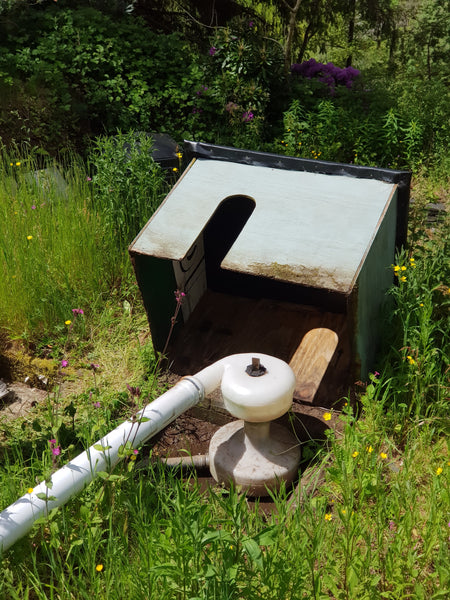
When it uses water for flushing and conveyance of the solid waste. Our favourite device for this is the Aquatron which separates liquids and flush water from solids without any moving parts through adhesion. Genius!
How to empty a composting toilet with a urine diverter
As magical as composting toilets may be, someone still has to empty the bathroom situation manually. The frequency depends on the toilet and how many people are using it. A self-contained dry toilet with a urine diverter needs to be emptied when either the liquid or solid container is full. Since these two are separated, you can easily empty either whenever one reaches capacity.
But how do you actually empty a composting toilet? Well, for the liquid chamber, it's best to do it before it's completely full, and the best composting toilets on the market will notify you when the bottle is full to prevent any spillage. You can easily empty the liquid into a bathroom that’s hooked up to a sewer, or you may rid it in the wild so long as it is far enough away from any animals and freshwater sources (at least 200ft).
In most composting toilet systems, you can tell it's time to empty the solids bin when the handle gets tough to turn. A smart tip is to wait about 8 hours after your last bathroom visit before emptying the solid waste chamber. This gives the decomposition process a little head start, and emptying the solid waste bin is quick, easy, and painless. With our Cuddy, you won’t have this issue because we designed a stronger agitator handle, which is pretty easy to turn - so instead, you’ll need to keep an eye on the internal levels.
Always check with certain sanitary restrictions in the area that you are in, but most of the time, human waste is allowed to be thrown away in the garbage, so long as it is tied tightly in a bag. If you live off-grid and wish to use the compost toilet’s contents in your garden, it is best to wait at least 6 months before planting your human manure… or humanure!
What is “Humanure”, and what can I do with composted toilet poop?
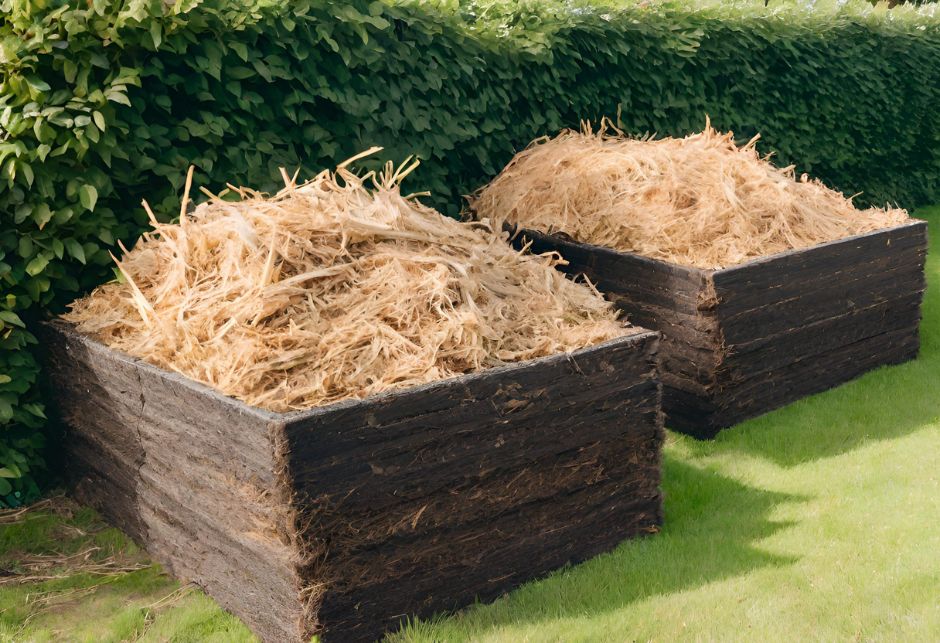
Humanure has even more incredible benefits than just its awesome name.
Human manure is a term that refers to when human poop is composted to create nutrient-rich fertilizer, which can be used for agricultural and horticultural purposes. The composting process allows for the decomposition of pathogens and converting toilet materials into a rich and fertile soil conditioner that can enhance soil quality and promote plant growth. It's an environmentally friendly and sustainable approach to managing human waste, often used in ecological or sustainable farming and gardening practices.
Properly managed humanure composting systems can reduce the environmental impact of sewage disposal and contribute to more sustainable agricultural practices.
For more information about humanure and what to do with composting toilet waste, we highly recommend the Humanure Handbook.
How often do you clean a compost toilet?
The answer is far less than you think if you have a split system.
The solids bin should be left as long as possible to allow the microorganisms to do their work, while the liquid bin only needs a little vinegar and water solution or bio-degradable soap when you empty it - a quick shake and you are done. Here’s our cleaning guide for the Cuddy, our product, to show you what we mean.
Where can you install a portable composting toilet?

The beauty of a portable solution is that you can use it wherever you are and in pretty much any situation you feel comfortable.
We’ve had customers install theirs in their RV bathrooms, campervan storage or wet rooms, sailboats, or even in the back of a car, along with a modesty tent for camping trips!
So what is a composting toilet?
The definition of a composting toilet is evolving quickly as people are embracing it as a more sustainable form of sanitation. Currently, the term composting toilet most often refers to waterless toilets that contains human waste in conditions that encourage the materials to start composting. When the contents of the toilet are composted the whole system can be referred to as a composting toilet system.
0 comments



